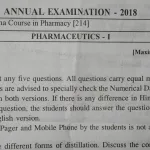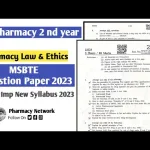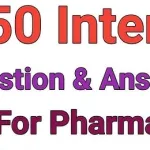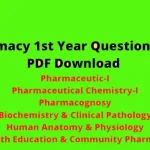Pharm D previous question papers are valuable resources for students to understand exam patterns and essential topics. They help in focused preparation by covering important concepts in various subjects. The questions and answers here are curated for clear understanding and easy learning.
Pharmaceutics
Question: What is the definition of pharmaceutics?
Answer: Pharmaceutics is the science of designing and formulating drugs into dosage forms for safe and effective administration to patients.
Question: Explain the term bioavailability.
Answer: Bioavailability refers to the proportion of a drug that enters the systemic circulation and is available at the site of action.
Question: What are excipients, and why are they important?
Answer: Excipients are inactive ingredients used in formulations to aid drug stability, administration, and absorption.
Question: Define sustained-release drug formulations.
Answer: Sustained-release formulations are designed to release drugs at a predetermined rate to maintain constant drug levels.
Question: What is the difference between tablets and capsules?
Answer: Tablets are compressed drug forms, while capsules are enclosed in gelatin shells, allowing for easier swallowing.
Question: What is the significance of pH in drug formulation?
Answer: pH affects drug solubility and stability, influencing absorption and therapeutic effectiveness.
Question: Explain the role of preservatives in pharmaceuticals.
Answer: Preservatives prevent microbial growth in formulations, ensuring product safety and longevity.
Question: What is lyophilization, and when is it used?
Answer: Lyophilization is freeze-drying, used for preserving sensitive drugs like proteins.
Question: What are effervescent tablets?
Answer: Effervescent tablets dissolve in water, releasing carbon dioxide and forming a solution for easy ingestion.
Question: Describe the process of granulation.
Answer: Granulation is the process of forming powder into granules for better flow and compression properties.
Pharmacology
Question: What is pharmacology?
Answer: Pharmacology is the study of drugs, their effects, mechanisms, and therapeutic uses.
Question: Differentiate between pharmacokinetics and pharmacodynamics.
Answer: Pharmacokinetics deals with drug movement in the body, while pharmacodynamics focuses on drug effects.
Question: What are agonists and antagonists?
Answer: Agonists activate receptors, producing effects; antagonists block receptors, preventing effects.
Question: Explain the term therapeutic index.
Answer: Therapeutic index measures the safety margin of a drug by comparing its effective and toxic doses.
Question: What is the role of the liver in drug metabolism?
Answer: The liver metabolizes drugs, making them easier to excrete.
Question: Define half-life in pharmacology.
Answer: Half-life is the time it takes for a drug’s plasma concentration to reduce by half.
Question: What is the difference between side effects and adverse effects?
Answer: Side effects are predictable, mild effects; adverse effects are severe and unexpected.
Question: Explain the concept of drug-receptor interaction.
Answer: Drug-receptor interaction involves drugs binding to specific receptors to exert effects.
Question: What are prodrugs?
Answer: Prodrugs are inactive compounds that become active after metabolism in the body.
Question: Describe the concept of dose-response relationship.
Answer: The dose-response relationship illustrates how drug effects change with varying doses.
Pharm D previous question papers provide a strong foundation for mastering essential subjects. By exploring detailed questions and answers, students can effectively prepare for exams and build a deep understanding of core concepts, ensuring success in their academic and professional journey.
Latest Posts
- Step-by-step guide to download and apply for jee mains admit card 202
- Comprehensive 2025 government holidays and recruitment details for job seekers
- JEE Mains Admit Card 2025: Your Step-by-Step Guide to Downloading the Hall Ticket
- Everything You Need to Know About 2025 Government Holidays Recruitment
- Comprehensive Guide to rrb d group recruitment 2025 – Eligibility, Vacancies, and Application
- Detailed guide to nps trust recruitment 2025 vacancies, eligibility and apply process
- Comprehensive guide to hpcl recruitment 2025 notification, vacancies, and application process
- ignou bed admission 2025 complete recruitment guide with eligibility and process
- Comprehensive Guide to Indian Army Agniveer Recruitment 2025 Notification and Jobs
- Everything You Must Know About CBSE Board Exams 2025 Changes & New Rules






